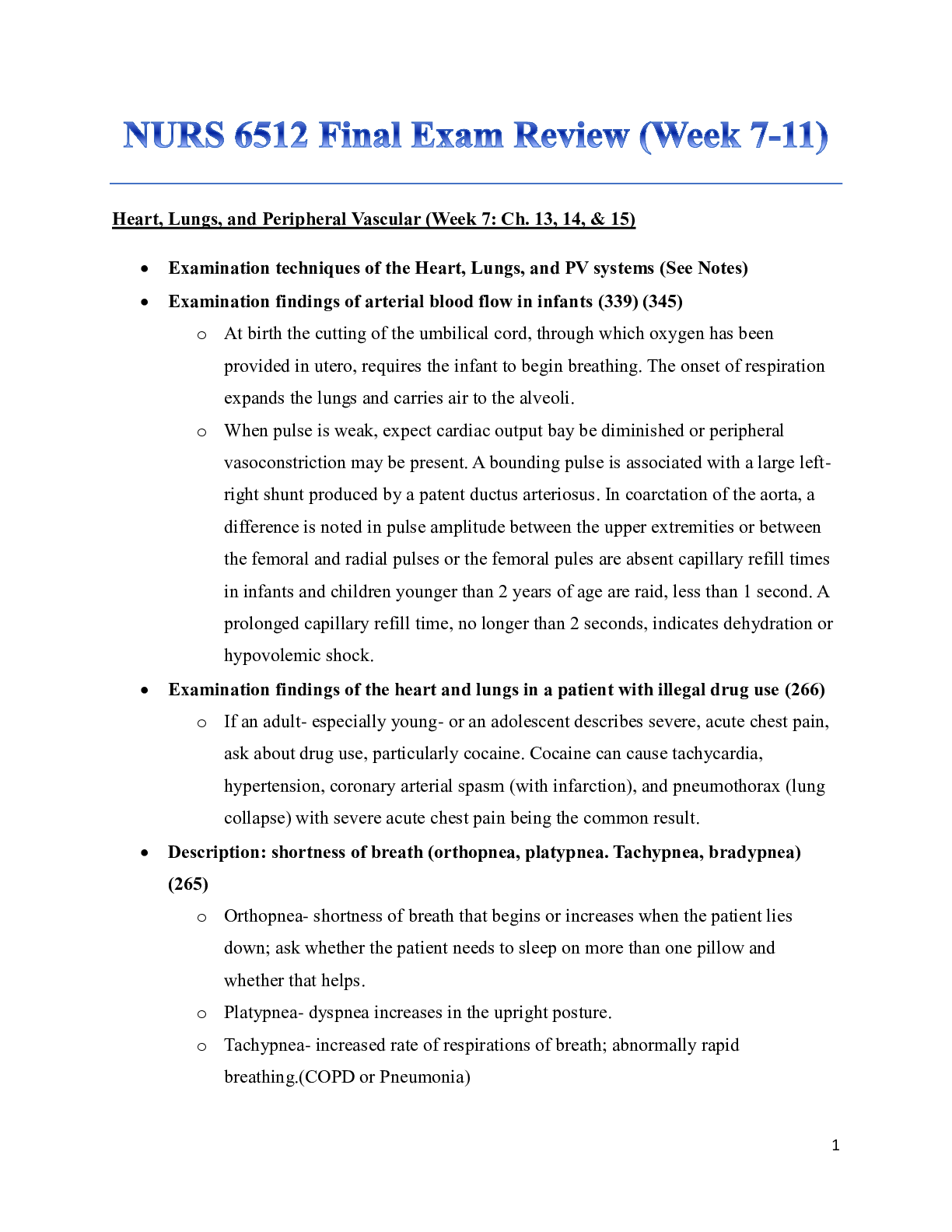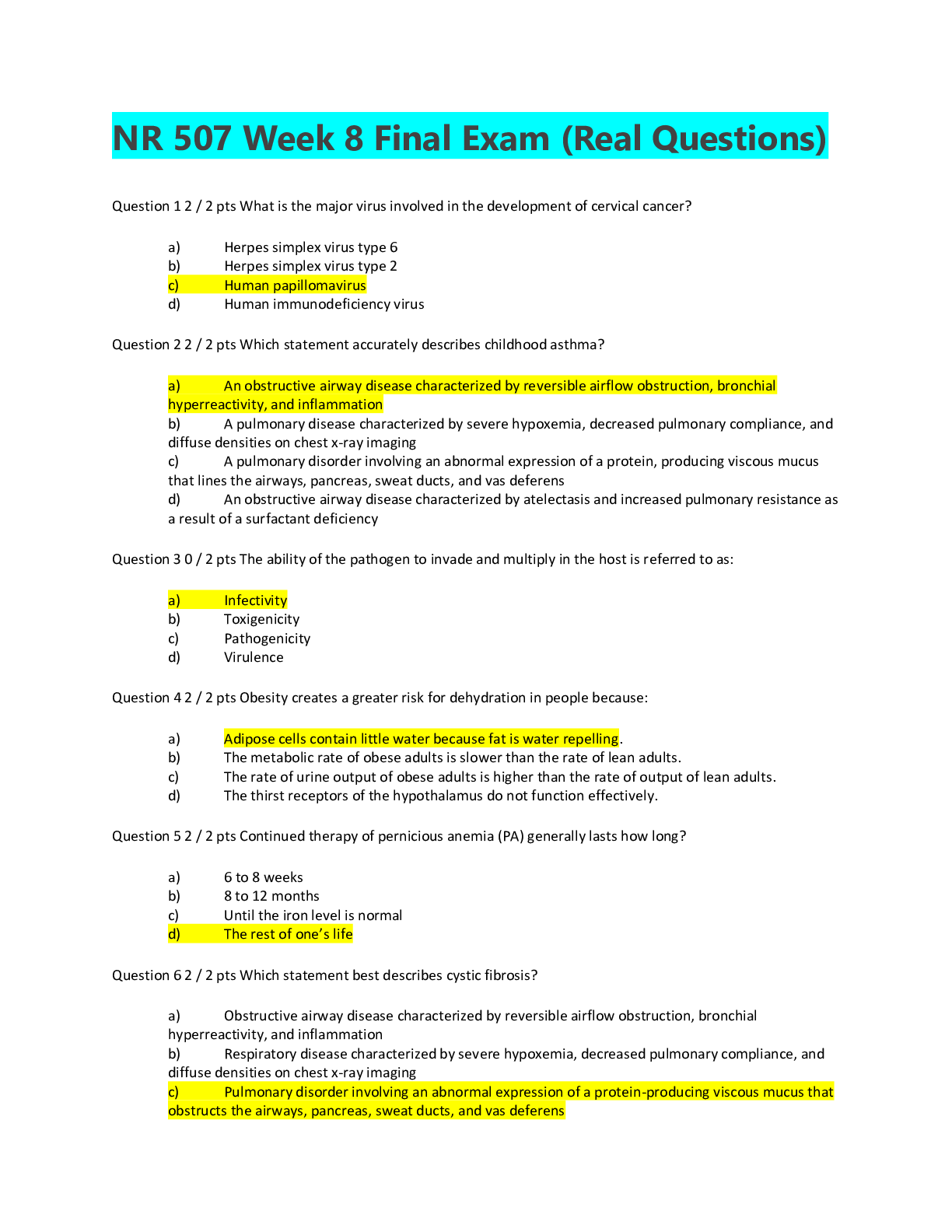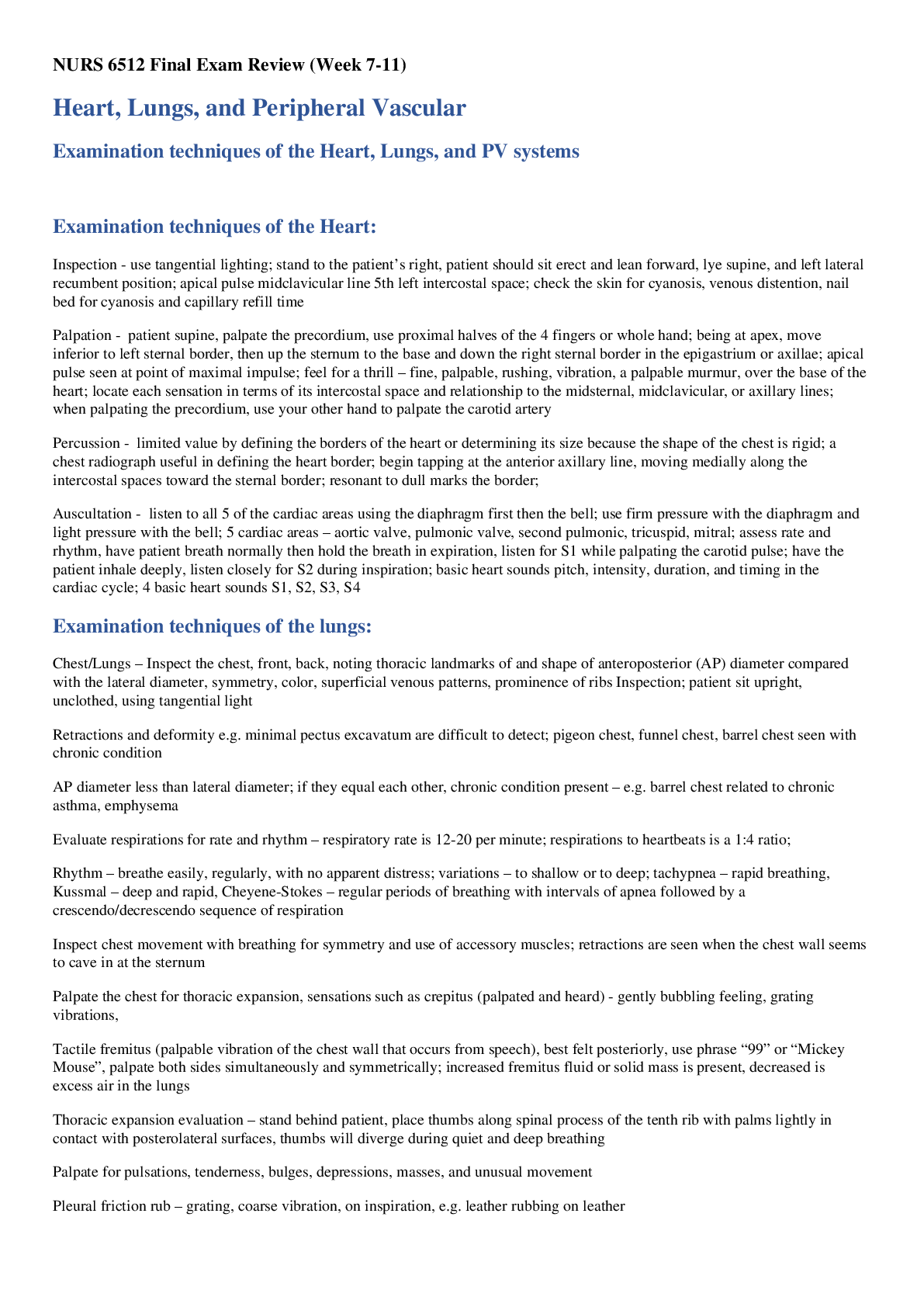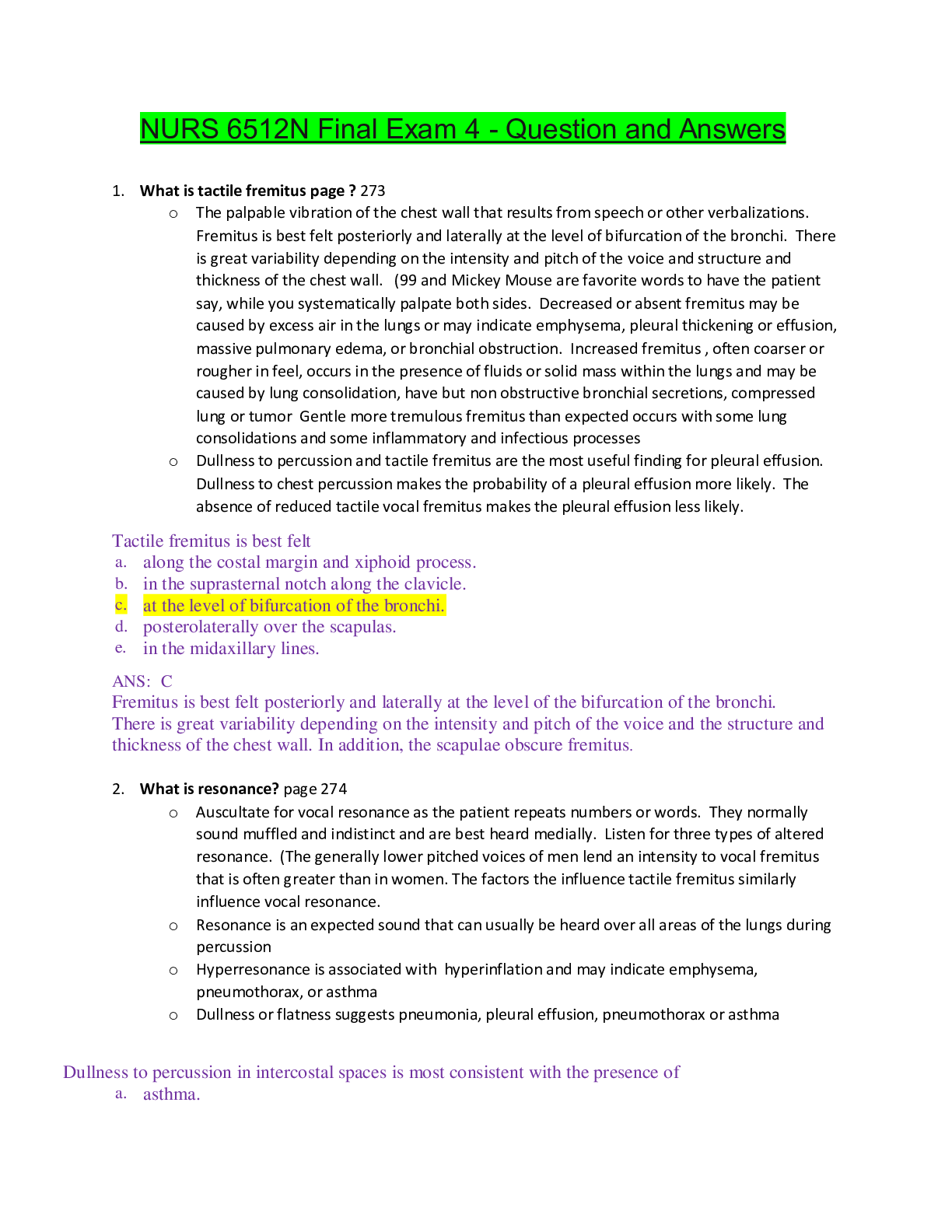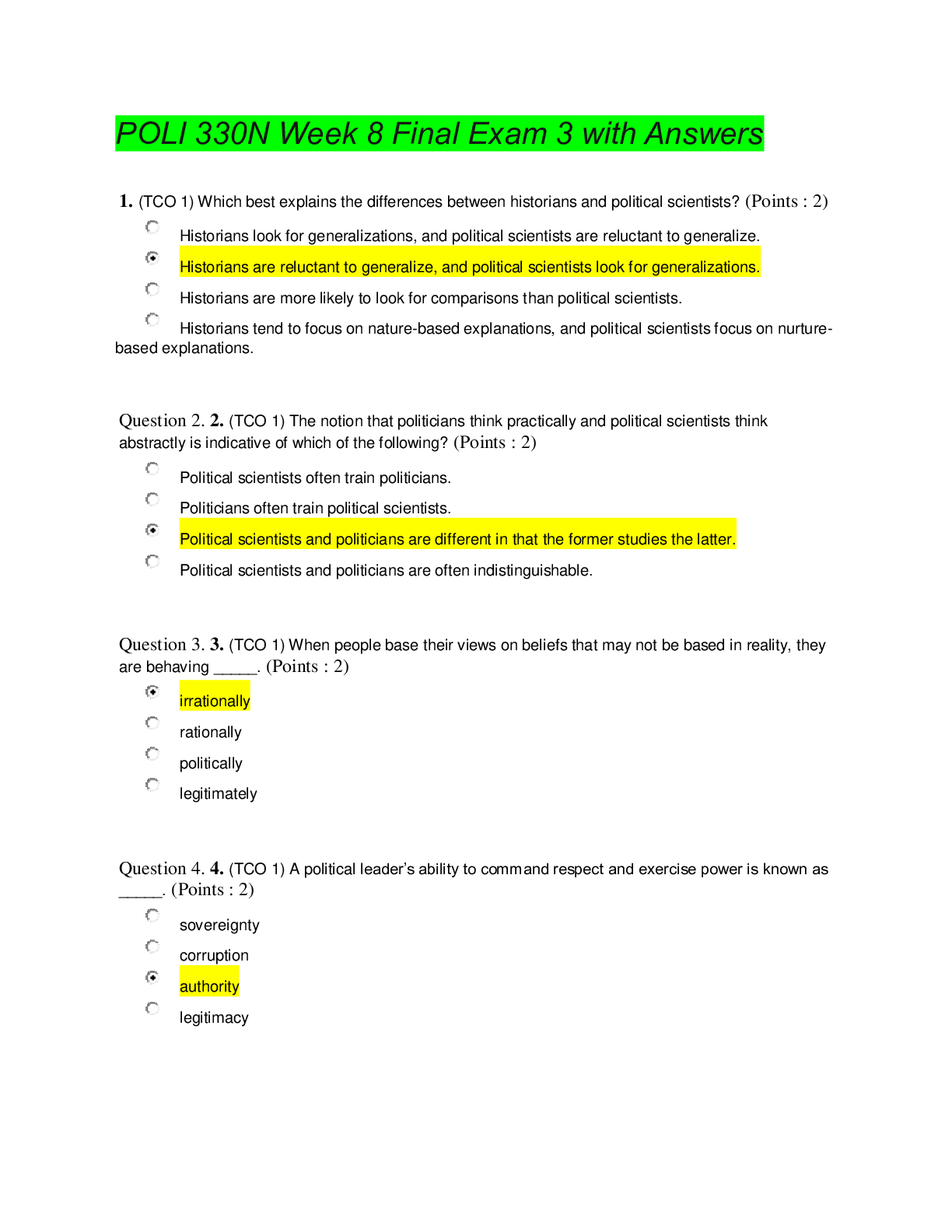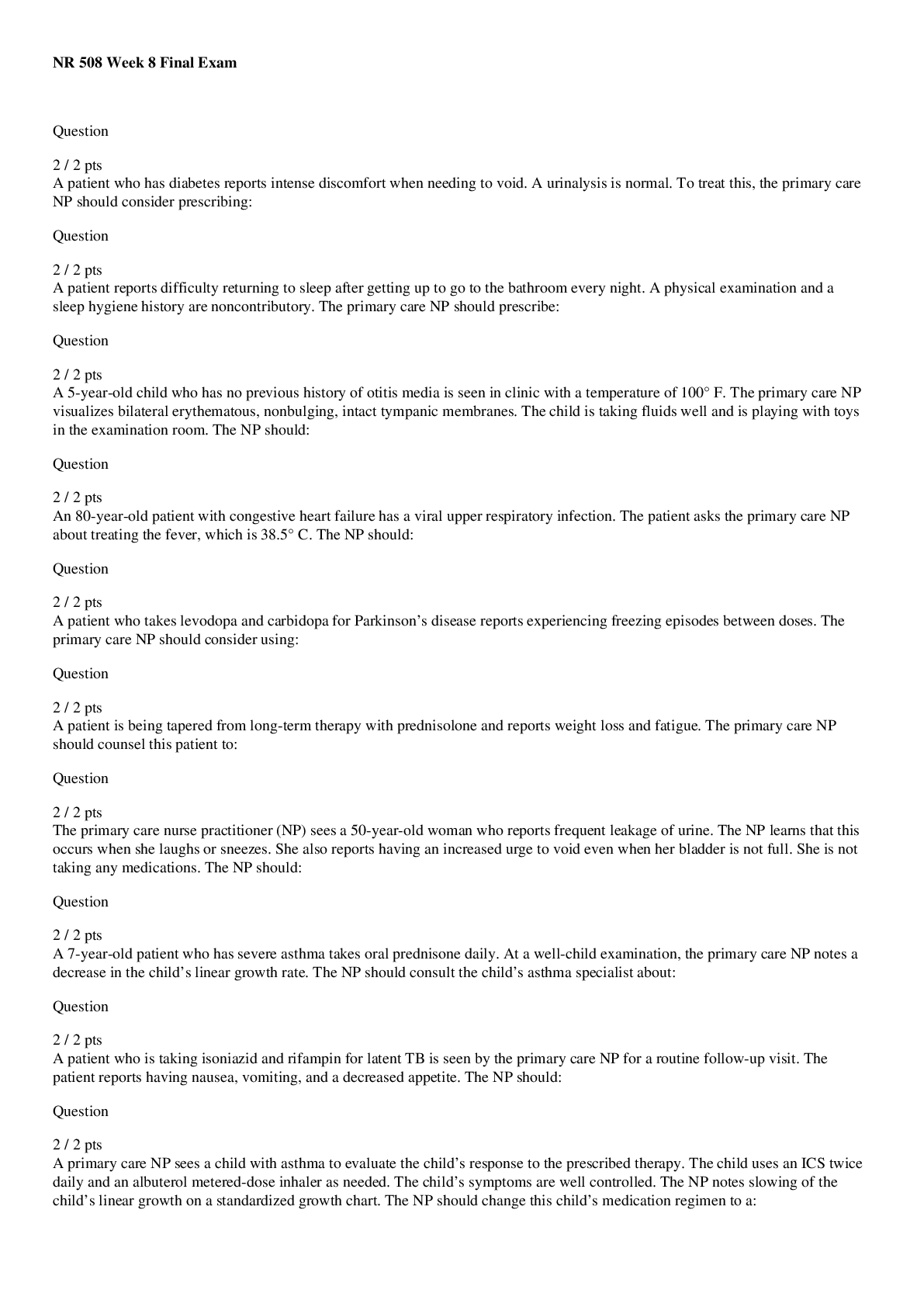*NURSING > Final Exam Review > MED surg-201-final-exam-questions-answers-explained-updated-test-bank-20192020-west-coast-university (All)
MED surg-201-final-exam-questions-answers-explained-updated-test-bank-20192020-west-coast-university. (1)_removed
Document Content and Description Below
7. The nurse in the outpatient clinic has obtained health histories for these new patients. Which patient may need referral for genetic testing? a. 35-year-old patient whose maternal grandparents died... after strokes at ages 90 and 96 b. 18-year-old patient with a positive pregnancy test whose first child has cerebral palsy c. 34-year-old patient who has a sibling with newly diagnosed polycystic kidney disease d. 50-year-old patient with a history of cigarette smoking who is complaining of dyspnea ANS: C The adult form of polycystic kidney disease is an autosomal dominant disorder and frequently it is asymptomatic until the patient is older. Presymptomatic testing will give the patient information that will be useful in guiding lifestyle and childbearing choices. The other patients do not have any indication of genetic disorders or need for genetic testing. 14. An adolescent patient seeks care in the emergency department after sharing needles forheroin injection with a friend who has hepatitis B. To provide immediate protection from infection, what medication will the nurse administer? a. Corticosteroids b. Gamma globulin c. Hepatitis B vaccine d. Fresh frozen plasma ANS: B The patient should first receive antibodies for hepatitis B from injection of gamma globulin. The hepatitis B vaccination series should be started to provide active immunity. Fresh frozen plasma and corticosteroids will not be effective in preventing hepatitis B in the patient. 6. A patient who is diagnosed with cervical cancer that is classified as Tis, N0, M0 asks the nurse what the letters and numbers mean. Which response by the nurse is most appropriate? a. “The cancer involves only the cervix.” b. “The cancer cells look almost like normal cells.” c. “Further testing is needed to determine the spread of the cancer.” d. “It is difficult to determine the original site of the cervical cancer.” ANS: A Cancer in situ indicates that the cancer is localized to the cervix and is not invasive at this time. Cell differentiation is not indicated by clinical staging. Because the cancer is in situ, the origin is the cervix. Further testing is not indicated given that the cancer has not spread. 10. External-beam radiation is planned for a patient with cervical cancer. What instructions should the nurse give to the patient to prevent complications from the effects of the radiation? a. Test all stools for the presence of blood. b. Maintain a high-residue, high-fiber diet. c. Clean the perianal area carefully after every bowel movement. d. Inspect the mouth and throat daily for the appearance of thrush. ANS: C Stuvia.com - The Marketplace to Buy and Sell your Study Material Radiation to the abdomen will affect organs in the radiation path, such as the bowel, and cause frequent diarrhea. Careful cleaning of this area will help decrease the risk for skin breakdown and infection. Stools are likely to have occult blood from the inflammation associated with radiation, so routine testing of stools for blood is not indicated. Radiation to the abdomen will not cause stomatitis. A low-residue diet is recommended to avoid irritation of the bowel when patients receive abdominal radiation. 11. The nurse notes that a patient who was admitted with diabetic ketoacidosis has rapid, deep respirations. Which action should the nurse take? a. Give the prescribed PRN lorazepam (Ativan). b. Start the prescribed PRN oxygen at 2 to 4 L/min. c. Administer the prescribed normal saline bolus and insulin. d. Encourage the patient to take deep, slow breaths with guided imagery. ANS: C The rapid, deep (Kussmaul) respirations indicate a metabolic acidosis and the need for correction of the acidosis with a saline bolus to prevent hypovolemia followed by insulin administration to allow glucose to reenter the cells. Oxygen therapy is not indicated because there is no indication that the increased respiratory rate is related to hypoxemia. The respiratory pattern is compensatory, and the patient will not be able to slow the respiratory rate. Lorazepam administration will slow the respiratory rate and increase the level of acidosis. 17. The nurse is caring for a patient who has a calcium level of 12.1 mg/dL. Which nursing action should the nurse include on the care plan? a. Maintain the patient on bed rest. b. Auscultate lung sounds every 4 hours. c. Monitor for Trousseau’s and Chvostek’s signs. d. Encourage fluid intake up to 4000 mL every day. ANS: D To decrease the risk for renal calculi, the patient should have a fluid intake of 3000 to 4000 mL daily. Ambulation helps decrease the loss of calcium from bone and is encouraged in patients with hypercalcemia. Trousseau’s and Chvostek’s signs are monitored when there is a possibility of hypocalcemia. There is no indication that the patient needs frequent assessment of lung sounds, although these would be assessed every shift. 26. A patient who had a transverse colectomy for diverticulosis 18 hours ago has nasogastric suction and is complaining of anxiety and incisional pain. The patient’s respiratory rate is 32 breaths/minute and the arterial blood gases (ABGs) indicate respiratory alkalosis. Which action should the nurse take first? a. Discontinue the nasogastric suction. b. Give the patient the PRN IV morphine sulfate 4 mg. c. Notify the health care provider about the ABG results. d. Teach the patient how to take slow, deep breaths when anxious. ANS: B The patient’s respiratory alkalosis is caused by the increased respiratory rate associated with pain and anxiety. The nurse’s first action should be to medicate the patient for pain. Although the nasogastric suction may contribute to the alkalosis, it is not appropriate to discontinue the tube when the patient needs gastric suction. The health care provider may be notified about the ABGs but is likely to instruct the nurse to medicate for pain. The patient will not be able to take slow, deep breaths when experiencing pain [Show More]
Last updated: 1 year ago
Preview 1 out of 89 pages
Instant download
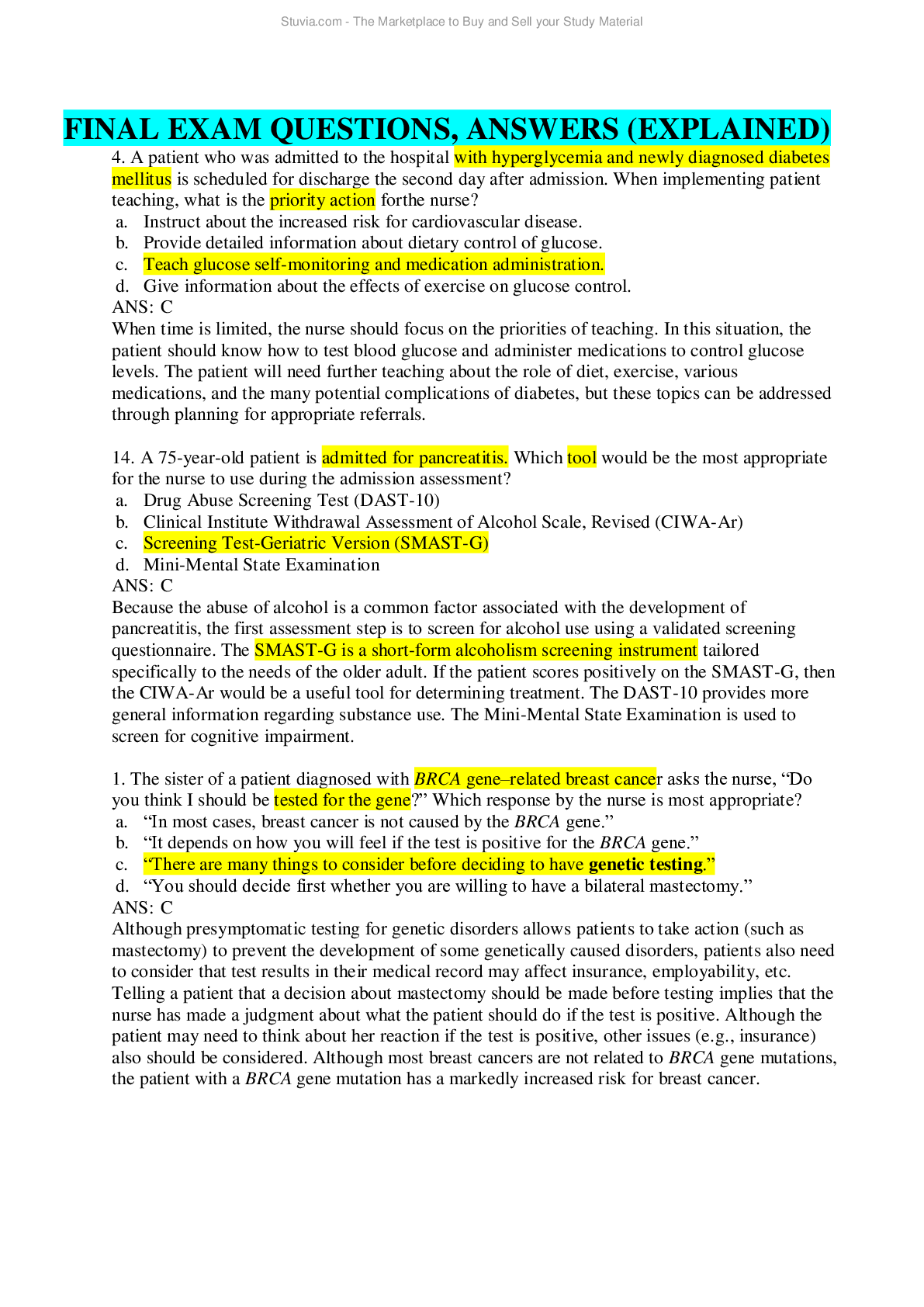
Buy this document to get the full access instantly
Instant Download Access after purchase
Add to cartInstant download
Reviews( 0 )
Document information
Connected school, study & course
About the document
Uploaded On
Apr 22, 2021
Number of pages
89
Written in
Additional information
This document has been written for:
Uploaded
Apr 22, 2021
Downloads
0
Views
51

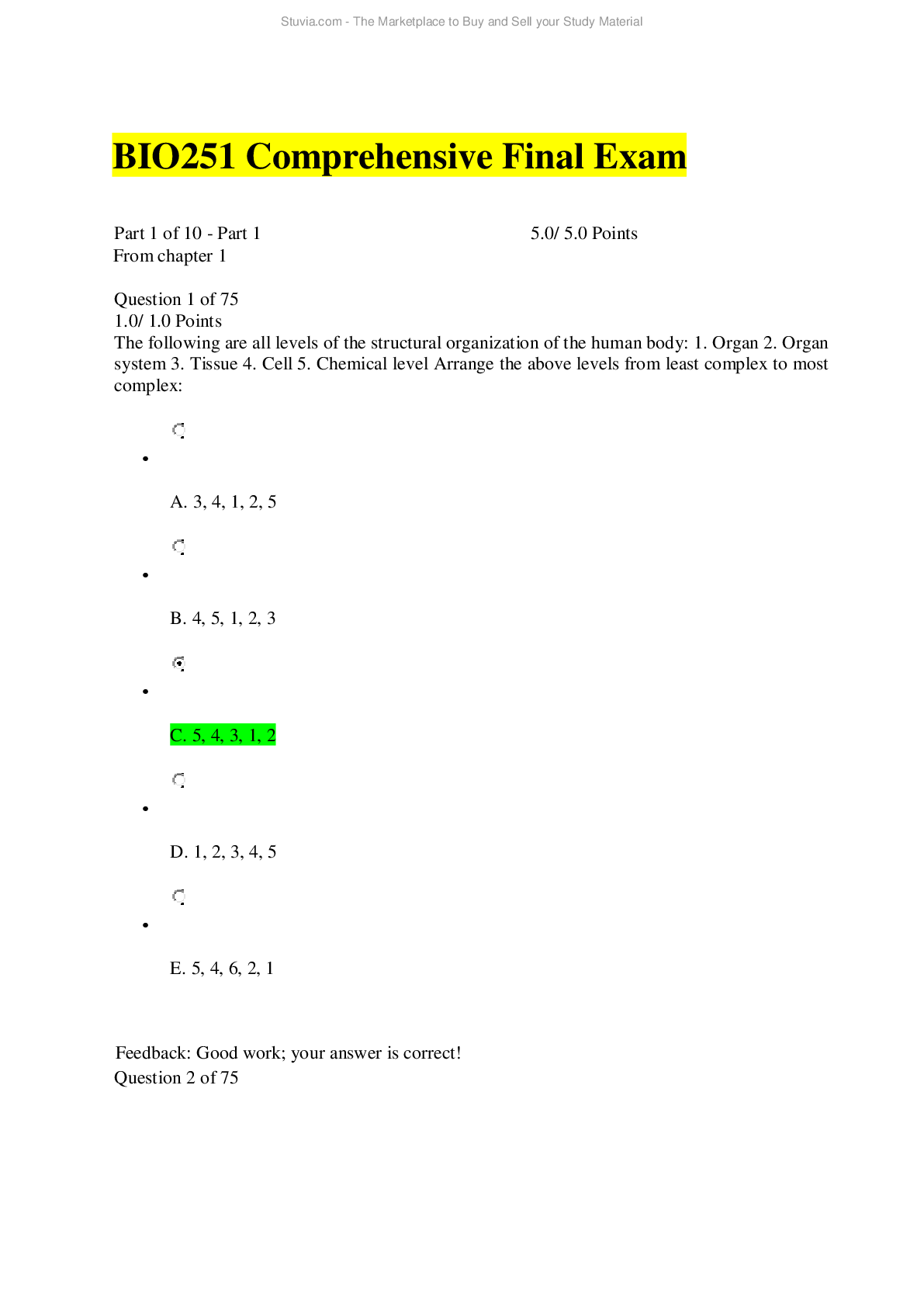

 (1)_removed.png)
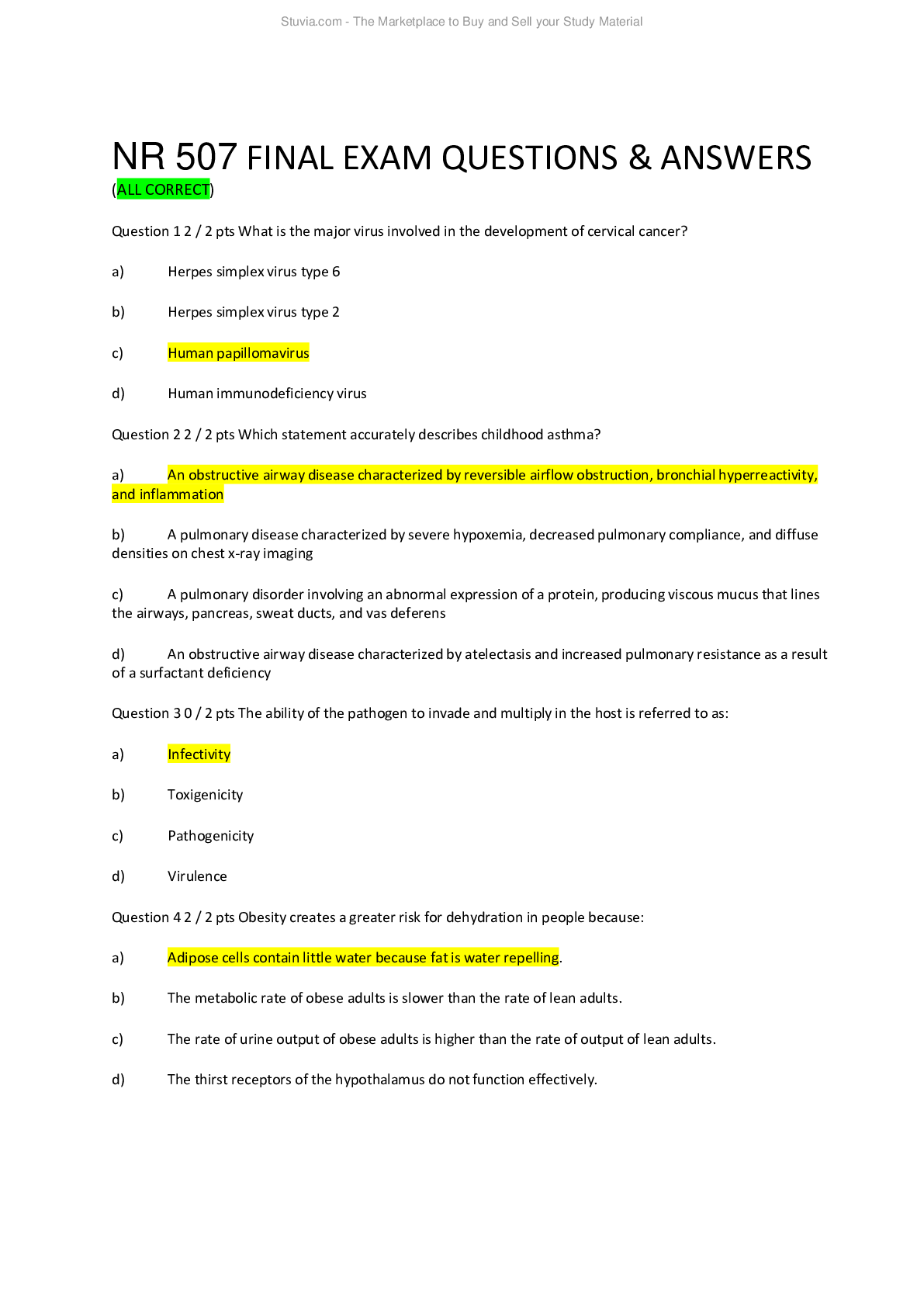


_removed.png)
_removed.png)
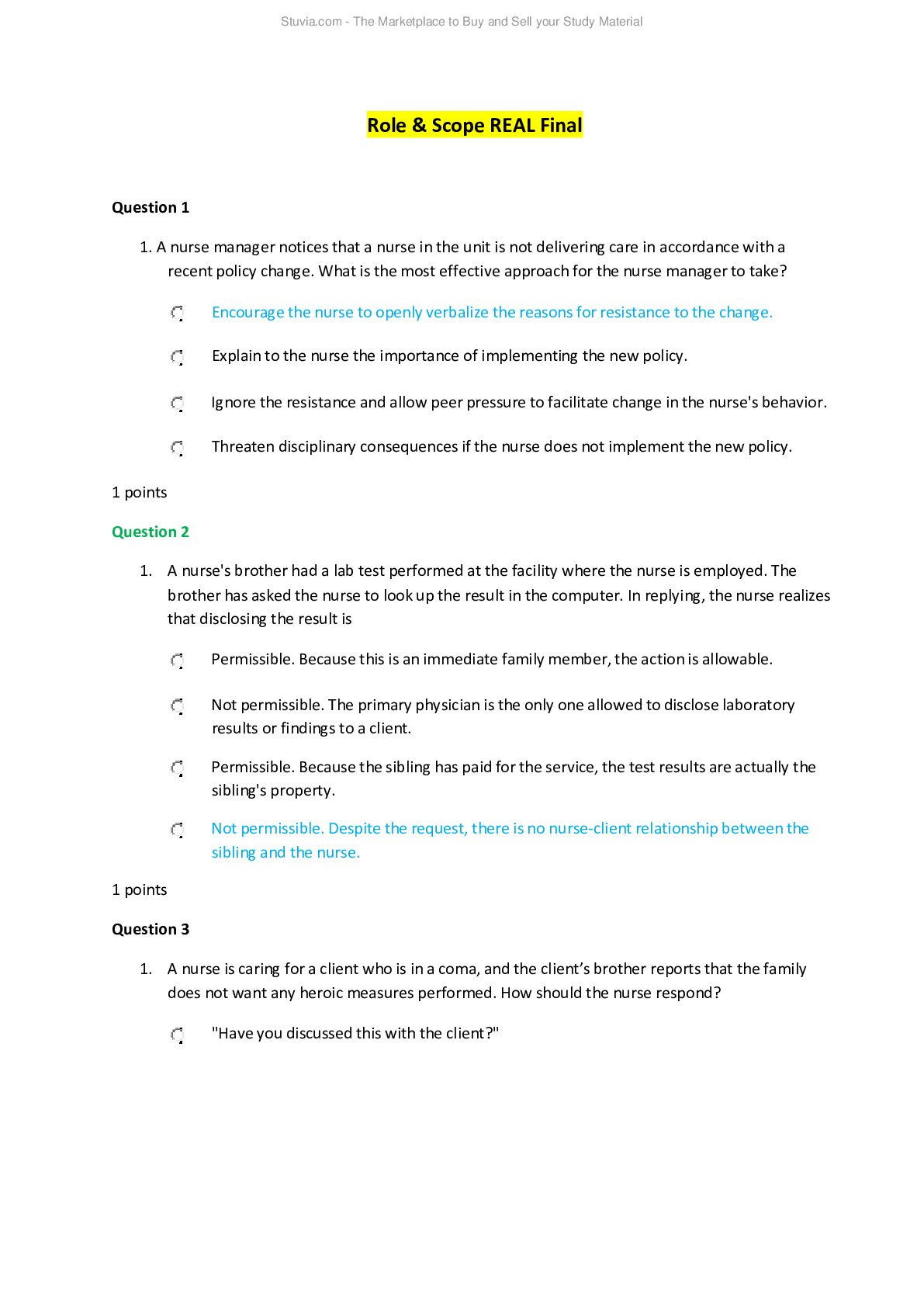
_removed.png)
